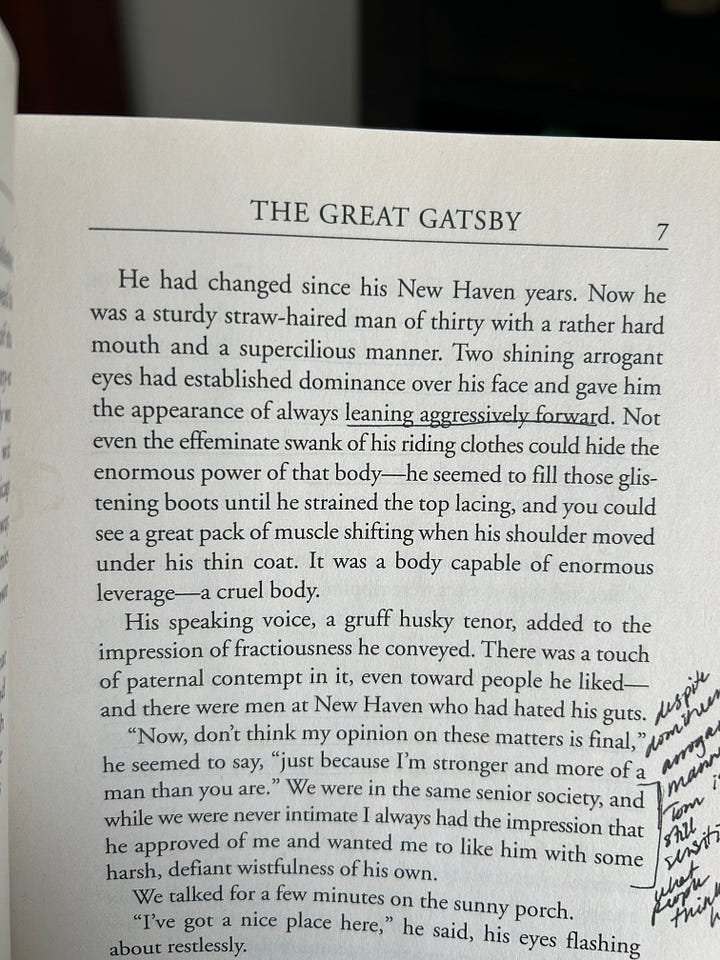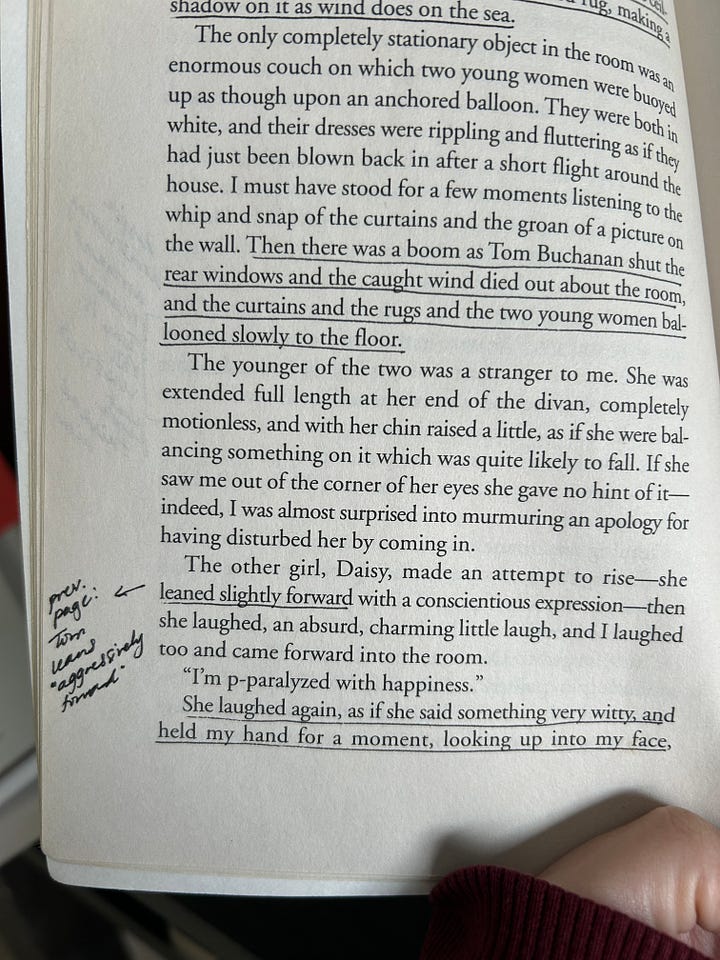One of the things I’ve been struggling with while writing my novel is that I can’t seem to read anything new. I pick up a book I haven’t read before, get a few pages in, but can’t finish it. Thoughts about my writing creep in and then I’m back at my laptop, typing my little novel away.
This is good for me as a writer, but not for me as a reader.
The problem is that I really miss reading. I don’t feel like myself if I’m not reading anything at the moment.
After some trial and error, I found a workaround for this desire to read but inability to read anything new. When I’m itching to read something while writing, I devote several weeks obsessing over my favorite novels.
I don’t mean just rereading my favorite books, which I am doing. Rereading and close reading are parts of it. I mean, I’ve been getting really obsessed with the book and devoting myself to studying it inside and out. Right now, I’m doing it with The Great Gatsby.
And the best part is the obsession seems to be paying off while writing my own novel.
By taking the time to slowly reread Gatsby, I’m paying attention to details I’ve missed in my several previous readings. I’m paying attention to things like how Tom leans “aggressively forward” and Daisy leans “slightly forward” in the reader’s first introduction to them, the difference in their lean less than page apart.


Does this seem like over-reading? Grasping at irrelevant details in search of greater textual meaning? Maybe I am. But it’s forcing me to pay attention and actively engage with the text.
To supplement my close reading, I’ve added plenty of other research and activities.
If you’re like me and struggle to read something new while writing, let me pitch you the idea of going back to a favorite novel, read it slowly, and become obsessed with it. Pay attention to how a sentence propels the plot forward, how characters are introduced, to all the tiny descriptions you may have missed during your other readings.
And here are some things you can add on to it to bolster your understanding, both as a reader and as a writer:
Find academic articles about what in particular interests you. There’s no shortage of Gatsby-related academic research, which makes this easier for me. But if you’ve got a favorite classic novel, I’d bet you can find plenty on it. Act like you’re going back to school. JSTOR is a great resource. A free personal account lets you read up to 100 articles every 30 days. (JSTOR, I love you, please sponsor me.) Google Scholar is another option.
Analyze media and art related to it. If there are movie or TV show adaptations, watch them. What’s different between the text and the adaptation? How does the adaptation supplement the text or provide new insight? I’ve watched Baz Luhrmann’s 2013 movie adaptation several times, though I still need to get to the 1974 film. I’ve parsed through each line of Lorde’s “Green Light” (which may not be directly related to Gatsby, but I love Lorde and am convinced the song is grappling with similar themes to the book in addition to its green light symbolism). There’s probably a public Spotify playlist someone’s made about the book. How does each song relate to the book?
Find college course syllabi. Google “[YOUR FAVORITE BOOK] college syllabus” and you’ll probably find several great college-course syllabi that will give you academic articles and other readings to add. What a hack! You can basically take a college level course all by yourself, at your own pace! In my search, I was even able to find a free video lecture about Gatsby from Yale.
Reverse outline. When you’re writing a book, oftentimes you’ll start with an outline. This is the opposite process: sit down with the book and map out the plot and each plot point. What’s the catalyst? When is the theme stated? Most books can probably fit in the 3 Act Structure. As I’m reading, I take notes on the plot points and map them out. In doing so, I see the bigger story structure as well as the smaller textual pieces that work in each act. I’m thinking about the book as though I were writing it. (If you haven’t read Save the Cat! Writes a Novel, this book may be helpful on structure.)
This is probably the single-most helpful activity for me as I’ve been writing my own novel-- I can compare my novel’s structure side by side with books I love and go, Okay, what pieces am I missing here? How do I need to pace them? How did Fitzgerald do it?
Write a dumb amount of essays. You’ve probably got a Substack account, so consider this a project to add to your newsletter. We’re all readers, we want to know what you love to read. At this point in your close reading and research, you probably have several ideas of things that you could write about related to your book. So do it! Again, the college course syllabus might help you here. And you can always google “[YOU FAVORITE BOOK] essay prompts.”
This is the process I’ve used for my Gatsby rereading as well as some of my other favorite books while I’ve been writing. I’m able to read but also able to analyze these books like a writer, rather than just an appreciative reader. I like to think it’s helping.
If you’re like me and struggle with reading something new while writing, but you desperately want to read something, try going back to your favorite book and do a reverse outline. Read some academic articles about it. Get obsessed.
Those are my thoughts for now. Are you able to read new books while writing? What’s your favorite book to reread?
<3,
Megan






I loved this! It was so helpful, and I’m definitely going to implement the obsessing over a book suggestion while I’m writing :)
Tbh I have the opposite problem. I like reading more than I like writing in the sense that I am constantly reading but I don’t necessarily write every day. In fact I need active time away from the page. But I love what you say about rereading books that you love. tbh its so helpful to do a close reading of both books you like and don’t like to see what makes them tick on a line by line level. Like if you have such strong emotions to a scene in the Great Gatsby what are all the elements (on a cellular level) that help in creating that response.